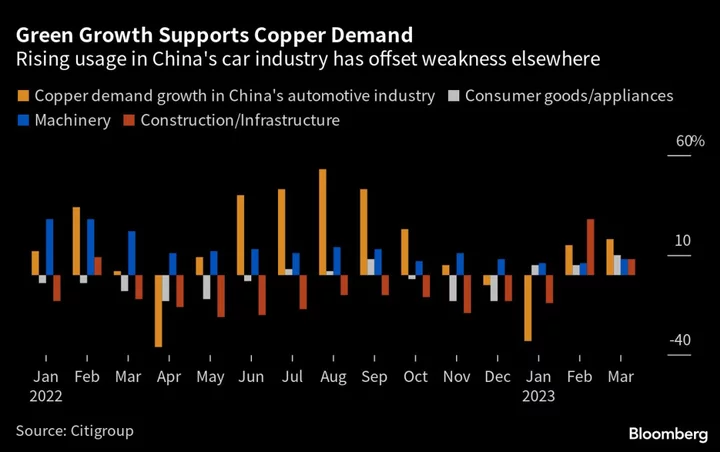Investors look set to pile into the copper market on an unprecedented scale in the next few years as usage surges in electric vehicles and renewable energy, according to Citigroup Inc.
The key industrial metal is widely known as a proxy for global economic activity, and prices have slumped in recent months on weakening demand from traditional sectors like construction and consumer goods. Even staunch copper bulls like Goldman Sachs Group Inc. have been pulling in their horns, saying they were wrong in predicting sharp gains in prices this year.
But copper is fast emerging as the go-to commodity for investors looking for exposure to the energy transition, and they’re likely to pile in quickly as soon as the gloomy global growth outlook starts to improve, Max Layton, Citi’s managing director for commodities research, said in an interview.
That will set the stage for a buying frenzy as orders from car-makers and grid operators flood in. The bank predicts that rising allocations from index-tracking investors and hedge funds could help boost net bullish positioning in the copper market to about 4 million tons by 2025, a sharp reversal of current bearish sentiment. That would be equal to about a fifth of global supply and double a prior peak seen in 2021.
As usage starts to soar, rising hedging activity from car-makers could add a further 1 million tons in long positions, bringing a wall of money into the futures markets just as demand starts to race ahead of supply in the physical industry. That will help push copper to a record high, Citi said.
“If you want to put on a decarbonization trade in commodities, the only truly liquid commodity is copper, and it’s the most liquid by a country mile,” Layton said by phone from London. “Copper’s unique characteristics mean that it could make oil’s 2008 bull run look like child’s play.”
The bank is advising investors and consumers to start purchasing soon while a weak macroeconomic backdrop keeps prices at around $8,300 a ton. Citi said copper may dip further in the short term, but should begin rallying within six to 12 months, topping out at about $15,000 in 2025 under the most bullish scenario.
Copper soared to a record of nearly $11,000 in early 2022, as a surge in demand during the pandemic left the industry critically low on stock and the war in Ukraine stoked fears over supplies from Russia. During the rally, Goldman Sachs Group Inc., BlackRock Inc. and Trafigura Group predicted the green energy revolution would drive prices much higher still, but so far that’s been more than offset by China’s tepid post-lockdown recovery, an industrial recession in Europe and a rising interest rates.
Sentiment has soured to the extent that on a net basis investors have turned bearish on copper for the first time in three years on the London Metal Exchange. Even so, the bellwether metal has held up far better than some other industrial commodities like zinc or oil this year, and Layton said investors would be betting against it much more heavily if it weren’t for the bright long-term outlook for demand.
Copper miners are already making strong margins at today’s spot prices, but there are widespread warnings that the industry will fall well short in delivering the additional supply needed as the energy transition gathers pace. As prices start to rise, Citi expects to see significant substitution away from copper in traditional sectors — such as consumer goods and air conditioning — and more economical use of copper in EVs and power generation. But the bank still expects an unprecedented gap to emerge between demand and mine supply over the next five to 10 years.
Rising prices for battery metals have pushed automakers to partially switch away from rare and volatile metals like cobalt in favor of iron and other more abundant materials over the past few years. But copper — which isn’t used in the battery itself but transmits power from the cells to an EV’s motor — isn’t as exposed to those kinds of shifts in battery chemistry. Copper’s deeper liquidity will also attract far more investment than other battery metals like lithium and nickel, Layton said.
The main long-term risk for copper is that its superior position as an electrical conductor is challenged by new cost-effective superconductors, Citigroup said in a report on Monday.
In the meantime, Citi thinks carmakers and other consumers will increasingly demand more than the market can supply, while the accelerating rollout of EVs and renewables will draw in a flood of investors.
“You don’t really know how high the price can go in that environment,” Layton said. “The whole market will be pushing back on it, but overall, looking at the historical context, you could easily see it in the $12,000-15,000 range.”
Copper prices were 0.2% lower at $8,280.50 a ton on the London Metal Exchange as of 9:55 a.m. Shanghai time on Thursday. Prices are virtually flat for the year, while aluminum has fallen 6.8%, zinc’s dropped 20%, and nickel’s lost about 30%.

